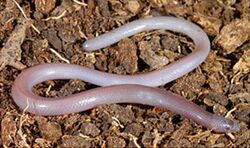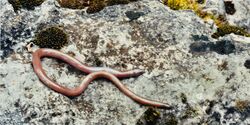Biology:Mexican blind lizard
| Mexican blind lizard | |
|---|---|

| |
| Scientific classification | |
| Domain: | Eukaryota |
| Kingdom: | Animalia |
| Phylum: | Chordata |
| Class: | Reptilia |
| Order: | Squamata |
| Family: | Dibamidae |
| Genus: | Anelytropsis Cope, 1885 |
| Species: | A. papillosus
|
| Binomial name | |
| Anelytropsis papillosus Cope, 1885
| |
The Mexican blind lizard (Anelytropsis papillosus) is a species of legless lizard in the family Dibamidae, and the only species in the genus Anelytropsis.[2] It is endemic to Mexico.[1][2] They look like Amphisbaenia, but are in fact, only distantly related.[3]
Etymology
Although early authors did not discuss the etymology, the generic name, Anelytropsis, is presumed to be based on the Greek words: ana = up opon; elytron = shield; ops = eye, in reference to the eyes which are concealed by ocular scales. The trivial name or specific epithet, papillosus, is Latin and refers to the minute papillae present on the scales in the anterior areas of the mouth and nose (rostral scale, first labial scale, and loreal).[4]
Description
The Mexican blind lizard is a limbless lizard, adapted for burrowing. The head is discernible from the cylindrical body by only a slightly greater width. There are no ear openings and each eye is entirely concealed under a single ocular plate. There are three large plates on the top of the head. The scales on the body are "scinciod", smooth with rounded edges, and may occur in even or odd numbered rows. It is a small species, ranging 20 - 50 cm. in total length. The tail is about one fourth of the total length of the lizard. Anelytropsis are brownish to flesh-colored, with some individuals exhibiting patches of pale scales producing a faint piebald appearance.[4][5]
Distribution
Anelytropsis papillosus is endemic to Mexico. It is known from northeastern regions of the country at elevations from 300 to 2300 meters, including southern Tamaulipas, eastern San Luis Potosí, northern Hidalgo and Querétaro, northern and central Veracruz, and extreme northern Oaxaca. Considering the fact that several confirmed localities are extremely close to state boundaries, its rarity, and its fossorial and secretive behavior, some authors have speculated it should be anticipated in areas west of the confirmed distribution, specifically southern Nuevo Leon, extreme eastern Guanajuato, and eastern Puebla.[4][6]
Ecology and natural history
Very little information has been published on the ecology and natural history of this rare and enigmatic species.[6] Hobart M. Smith reported finding two specimens in rotten logs near ant nests and noted they were "apparently" feeding on termites or ants in the logs.[7]
Collector's accounts of finding two specimens in San Luis Potosí, on separate occasions, stated that both lizards intensely bit the collectors fingers continuously for about three or four minutes when first handled. Then each lizard engaged in thanatosis (death feigning behavior), at which time the lizards were relaxed but slightly rigid with their mouths half open, one for about two or three minutes, the other for a briefer length of time but subsequently, it suddenly lashed its body and autotomized about half of its tail.[8]
Habitat
Locality records for the fossorial Anelytropsis papillosus do not correlate to surface vegetation communities or typical biogeographic patterns.[9] It has been reported from a remarkably wide spectrum of habitats, from Chihuahuan Desert scrub flats on the Mexican plateau, to cloud forest in the Sierra Madre Oriental (El Cielo Biosphere Reserve), and tropical deciduous forest on the coastal plain in Tamaulipas.[10][11] Pine -oak forest, tropical thorn forest, and semiarid deciduous vegetation have also been identified as collecting sites.[4][12] It has been found under boulders, rocks, and stones, under fallen logs, burrowing in rotten logs, and under dead yucca trees.[7][13][8] The distribution of the species falls mostly within the Mexican ecoregions of the tropical Veracruz moist forests, the Sierra Madre Oriental pine–oak forests, and southwestern portions of the Meseta Central matorral.
Conservation status
The Mexican Federal Government list Anelytropsis papillosus as a threatened species and it is protected by Mexican law.[14] In a conservation evaluation using Environmental Vulnerability Scores (EVS) [low, 3–9; medium, 10–13; high, 14–20], Anelytropsis papillosus was rated 10, a species of medium vulnerability.[15]:17 p. Conversely, the IUCN Red List of Threatened Species ranked Anelytropsis papillosus as a species of least concern.
References
- ↑ 1.0 1.1 Canseco-Márquez, L.; Mendoza-Quijano, F.; Ponce-Campos, P. (2007). "Anelytropsis papillosus". IUCN Red List of Threatened Species 2007: e.T64016A12735885. doi:10.2305/IUCN.UK.2007.RLTS.T64016A12735885.en.
- ↑ 2.0 2.1 Anelytropsis at the Reptarium.cz Reptile Database. Accessed 6 November 2017.
- ↑ Reeder, T. W.; Townsend, T. M.; Mulcahy, D. G.; Noonan, B. P.; Wood, P. L.; Sites, J. W.; Wiens, J. J. (2015). "Integrated analyses resolve conflicts over squamate reptile phylogeny and reveal unexpected placements for fossil taxa". PLOS ONE 10 (3): e0118199. doi:10.1371/journal.pone.0118199. PMID 25803280. Bibcode: 2015PLoSO..1018199R.
- ↑ 4.0 4.1 4.2 4.3 Campbell, Howard W. 1974. Catalogue of American Amphibians and Reptiles: Anelytropsis, A. papillosus. Society for the Study of Amphibians and Reptiles. 156:1–2.
- ↑ Cope, E. D. 1885. A Contribution to the Herpetology of Mexico. Proceedings of the American Philosophical Society. 22: 380-381
- ↑ 6.0 6.1 Valdez-Villavicencio, Jorge, Eli Garcia-Padilla, and Vicente Mata-Silva. 2016. Anelytropsis papillosus Cope, 1885 (Squamata: Dibamidae), an overlooked species in the state of Oaxaca, Mexico. Mesoamerican Herpetology 3(1):178-180 p.
- ↑ 7.0 7.1 Smith, Hobart M. 1935. Miscellaneous notes on Mexican lizards. University of Kansas Science Bulletin 22: 146.
- ↑ 8.0 8.1 Torres-Cervantes, Ricardo J., Xóchitl Hernándex-Ibarra, and Aurelio Ramírez-Bautista. 2004. Anelytropsis papillosus (Mexican Blind Lizard), Death Feigning and Autotomy. Herpetological Review 35(4): 384 p.
- ↑ Dixon, James R. and Julio A. Lemos Espinal. 2010. Amphibians and Reptiles of the State of Querétaro, Mexico. Published jointly by Texas A&M University, College Station, Universidad Nacional Autónoma de México, and CONABIO. xiv, 428 pp. [pages 211-212] ISBN:978-607-7607-22-9
- ↑ Farr, William L., Pablo A. Lavin-Murcio, and David Lazcano. 2007. New distributional records for amphibian and reptiles from the state of Tamaulipas, México. Herpetological Review 38(2): 230.
- ↑ Garcia-Padilla, Elí, and William L. Farr. 2010. Anelytropsis papillosus (Mexican Blind Lizard) México: Tamaulipas. Herpetological Review 41(4); 511
- ↑ Axtell, Ralph W. 1958. A northward range extension for the lizard Anelytropsis papillosis, with some notes on the distribution and habits of several other Mexican lizards. Herpetologica 14(4): 189–191.
- ↑ Mendoza-Quijano, Fernando, Efrín Hernández Garcia, and Walter Schmidt Ballardo. 1993. Anelytropsis papillosus (Mexican Blind Lizard) México: Hidalgo. Herpetological Review 24(2): 66 p.
- ↑ SEMARNAT (Secretaría de Medio Ambiente y Recursos Naturales). 2019. Norma Official Mexicana, NOM-059-SEMARNAT-2019, protección ambiental-especies nativas de México de flora y fauna silvestre-categorías de riesgo y especificaciones para su inclusión, exclusión o cambio-lista de especies en riesgo. Diario Oficial de la Federación. México, D.F., Mexico.
- ↑ Wilson, Larry D., Vicente Mata-Silva, and Jerry D. Johnson. 2013. A conservation reassessment of the reptiles of Mexico based on the EVS measure. Special Mexico Issue. Amphibian & Reptile Conservation 7(1): 1–47.
Wikidata ☰ Q19938963 entry
 |




